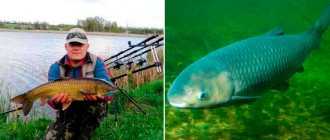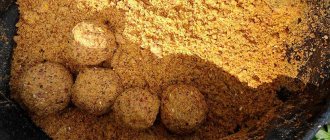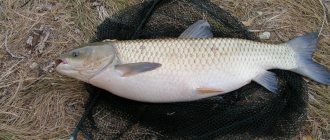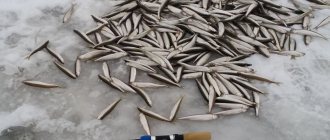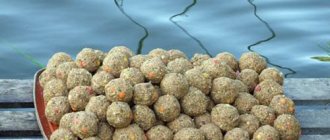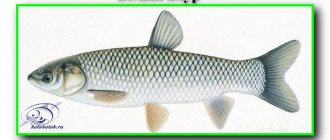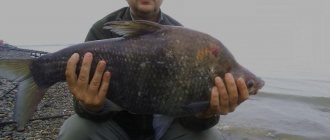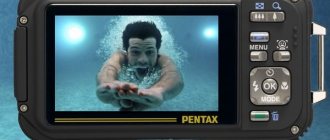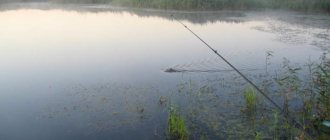Grass carp is quite popular among fishermen; it belongs to the carp family, so most fishing techniques are absolutely the same. Amur are herbivores and prefer dense thickets on the bottom, where the pike's habitat is located. Accordingly, in pike hunting grounds you can also catch grass carp.
Also, grass carp feel at ease in the same body of water with carp, despite similar habits, their food preferences are significantly different, thanks to this they do not compete with each other. In addition to bottom algae, the carp's diet includes plants growing along the edge of the shore, the roots of which are hidden in the water.
Catching grass carp in ponds with boilies
The boilie is a bait based on protein balls; the shape of the boilie does not matter when fishing. This bait came to our country in the mid-80s; previously it was used only in European countries, where fishermen mixed corn with soy flour, with the addition of eggs and semolina. Large balls were rolled from the resulting mixture, boiled and fished.
The only drawback of the boilie is that small individuals will not be able to swallow such bait.
The boilie is positioned on the hook a little non-standardly; it is not placed on the shank of the hook, but is placed as if behind the hook; hair is used for fastening. With this positioning of the bait, it does not scare the fish, but it also does not allow the boilie to be completely swallowed. When trying to swallow, the tip of the hook catches the fish by the lip, the rest depends on the skill of the fisherman. Equipment components:
- Hook
- Leash
- Boyle
When using hair equipment, use installation with a self-cutting function. The hook with the boilie is securely attached to the sinker, the fish rushes to the bait and swallows it completely with the hook, and the sinker facilitates self-hooking. Thanks to the large sinker, the line is always in tension, and the hook tip is exposed, so it is very difficult for the fish to spit out the bait.
Tips and tricks
When landing a large fish, do not suddenly stand up and rush at it with a landing net. Cupid is very timid, his reaction can be very sharp and unexpected. If the bite in the thickets has stopped in summer, you should move to warm shallow water. Perhaps the heat-loving fish decided to look for food in more comfortable conditions.
When using a bottom hook, small foam balls are attached to the hook to lift the bait above vegetation. They make it easy to adjust the bait's diving depth.
If float gear is chosen for fishing, then you need to play with the bait from time to time. A slight twitch will attract the fish's attention.
Fishing with bait such as reeds, algae and cabbage leaves requires care. A slight vibration of the tackle indicates that the grass carp is quietly eating the bait, and you need to hook it.
Catching grass carp in ponds using a feeder
Feeder fishing is popular due to the nature of the fish and its behavior. The food source for carp is phytoplankton and aquatic plants, so there is no shortage of food for it. The attention of an individual can only be attracted by a large volume of unusual bait.
Throwing bait with a feeder increases the chance of catching cupid. Although grass carp is a voracious fish, it does not immediately rush to the bait. He tentatively tastes the bait, sucking and pinching a little, while it is almost impossible to feel the bite. But the feeder rod has a sensitive flexible tip (quivertip) which is a reliable bite alarm.
If the fish does not notice anything suspicious, then it swallows the bait and does it abruptly. If you don’t hook it at this moment, it will go deep, but it’s not so easy to pull out a caught cupid; when you fish it out, it actively resists.
The manufacturer usually supplies 3 to 5 interchangeable tips with the rod, which have good strength and vary in rigidity. The rigidity indicator when fishing is especially important, because the weight of the fish can vary from 1 to 30 kilograms and reach 50 – 60 cm.
When fishing for strongly resisting fish, the line breaks quite often; this can be minimized by the correct equipment. For fishing, it is recommended to use the simplest paternoster, which is knitted on the main fishing line. The leash is attached above the feeder, and a piece of foam plastic is inserted into the feeder itself, this allows the feeder to float up and the bait to be washed out at a sufficient distance.
Complementary food at the correct density is washed out in 10 - 15 minutes, after which the tackle is refilled.
At the beginning of fishing, there is no need to throw bait in order not to scare away the cautious fish; to do this, first throw the feeder, and only after that, after a while, throw in the food.
The best depth for catching grass carp is considered to be 1-1.5 m, while the bait should be 10 cm above the bottom vegetation. Grass carp seriously resists when fishing and, sensing the proximity of the shore, makes a sharp jerk and if the clutch is not adjusted correctly, it can break the fishing line or break the fishing rod.
Successful fishing with a feeder is most promising in ponds, lakes, irrigation canals and reservoirs overgrown with vegetation. It is best to fish in the evening and morning hours, at this time the fish are the least careful.
Peculiarities of biting by season
As noted above: cupid is a heat-loving fish, therefore it appears in reservoirs only in the spring, when the temperature in the river or pond has warmed up to 13-15 degrees. This fact, however, is associated not only with the heat-loving nature of the fish reptile, but also with the fact that it is at this time that the first vegetation begins to appear, on which the fish feed.
You can go fishing in the second half of spring, when it becomes noticeably warmer. Greens, bloodworms and worms will be ideal as bait at this time.
Summer is the peak of the fishing season, so from the first days of June you can collect your fishing rod. At this time, literally everything that grows in the garden will do for complementary feeding, that is:
- Corn.
- Fresh cucumber.
- Berries and fruits.
You can fish with it until the onset of autumn.
Catching grass carp on a spinning rod
Among the features of spinning fishing, it should be noted that grass carp has the following habits:
- He has a fast and sharp bite
- Fishing is best at a depth of 1 to 4 m
For fishing, it is better to use a spinning rod with a reel. Grass carp loves to feed on reeds, so for fishing you need to use reeds that have been cleared of leaves, leaving only a few leaves on the top. In practice, such bait is not very effective, since the fish is shy and notices the unnaturalness of the situation.
Grass carp feeds just below the surface and makes strong jerks when swallowing the bait. Only speed and dexterity will help you catch it. When fishing, the hook must be well camouflaged in the upper sections of the reeds, and the fisherman must hide behind the reeds.
Catching grass carp with a float rod
Some fishermen prefer to use a float rod to catch grass carp. A float fishing rod for grass carp can sometimes be no less effective than other gear. It is best caught in the evening and morning hours, especially after the weather changes after the rains.
After feeding, grass carp does not bite for an hour, during which time you must remain silent.
How to catch grass carp with a fishing rod
When active, the fish takes the bait and without hesitation moves towards the reeds, at this time it is necessary to carry out a competent hooking so that the fish is properly hooked. For the fish to be brought out correctly, it needs to be a little tired; for this, the clutch must be set correctly.
Also, for fruitful fishing, you need a landing net with a handle length of at least 3 m; it will help you not to miss the fish, since grass carp near the shore begins to make crazy somersaults and can fall off.
Catching grass carp on a donk
Donka for white carp is considered the main and most effective method of catching this powerful and large fish. The most effective equipment for catching carp is the zig rig. There are 2 modifications of it, the most popular one uses a long leash made of fluorocarbon fishing line, the length of which varies depending on the distance from the bottom of the hook with foam.
You can also use a fixed zig rig with a running clip. Also a good equipment is a feeder or spring filled with porridge.
It is important that when casting the hook does not get stuck in the algae, so you need to check the bottom for vegetation in advance.
Grass carp is best caught in small areas, excluding holes, and it takes the bait not from the bottom, but a little higher.
Gear selection
If the hunt is for small animals, then you can use any type of fishing rod; thin-walled, expensive gear is also used. When purposefully catching large fish, you will need more serious models that can withstand the powerful resistance of the prey.
Plug tackle
This rod can be classified as universal; with its help it is possible to catch both specimens weighing up to 2 kg and trophy specimens. Its undeniable advantage is the accuracy of casting and the ability to simulate a free-sinking bait. To successfully catch large fish you need to use:
- A special carp fishing rod, the length of which is no more than 13 m.
- The cross-section of the scaffold depends here on the diameter of the shock-absorbing rubber. So, for rubber with a thickness of 2 mm, it is necessary to use a thread with a cross-section of 0.2 mm.
- The hook size varies in the range No. 5-10. Installation to the main line is carried out without a leash.
Important! In warm weather, a bait that slowly sinks into the water works well.
Match
Of all the float tackle, this rod is the most popular. Thanks to the friction clutch, the probability of successfully landing prey ashore is very high. In addition, the fishing distance increases significantly. Since the object of fishing lives in almost all horizons, the presence of a running float is simply necessary.
The tackle should consist of:
- carp rod 3.5-4 m long;
- a spinning reel with a spool size of 4000;
- fishing line with a cross section of 0.3 mm;
- hook No. 7-10;
- sliding sinker-olives, small pellets;
- weighted float (waggler).
Bottom tackle
When using a feeder, fishing for grass carp becomes both highly productive and exciting. The cast is made over long distances and as accurately as possible. In addition, the fisherman has the opportunity not only to get a good catch, but also to keep the fish at the fishing point for a long time. Another advantage of feeder gear is its high sensitivity.
To complete it you will need:
- fishing rod 3-3.5 m long with a test load of 40-80 g;
- inertia-free reel model with a spool of 3000-3500;
- monofilament fishing line (braid) with a cross-section of 0.3-0.4 mm;
- leash made of wood no more than 0.3 mm thick, 50-80 cm long;
- hook No. 8-10.
Catching grass carp on a crust of bread
In summer, grass carp have an increased metabolism and the fish are as active as possible. At this time, there is a huge amount of plant food in the reservoir, but to diversify the diet you can use a crust of bread on a float rod. To obtain the desired result, you must follow certain rules:
- Use a heavy weight that is attached to the main line
- A leash should be used at the end of the line, the length of which depends on the depth
- The planted bread is located at the surface of the water, the size should be no smaller than a matchbox
- It is best to use bread crust or stale bread as it has good buoyancy
Groundbaits for grass carp
In addition to the baits already described above, you can prepare, for example, tiger nuts with your own hands. They have a specific aroma that quickly spreads in the water and attracts fish.
Prepare nuts as follows:
- Boil them for an hour.
- Infuse in a closed and wrapped container until cooled.
- To enhance the aromatic properties, an attractant is introduced.
- Dry the nuts in the sun.
Important! Do not immediately put all the bait into the water. It is necessary to set aside a third in reserve in order to keep the collected fish in the fishing zone longer.
Another type of bait recommended for grass carp should consist of four components:
- “Float” baits;
- biting stimulants;
- flavored additives;
- Hercules cereal.
Wheat and buckwheat porridge, pearl barley, halva, bran, crushed sunflower seeds, boiled or canned corn are also used for complementary feeding.
Video: Bait for catching carp
Catching grass carp on corn
The most relish for grass carp is milk grains of corn, you can also use canned corn. The main bait is floating corn, which should be 10 cm from the bottom. Cupid is careful and takes the bait only when afloat.
You can also use fermented corn, it turns on even the most passive fish. Fans of old traditional fishing simply need steamed corn and mamalyga on corn flour. Hominy is boiled in a liter of water brought to a boil, adding a kilogram of corn flour and cooked over low heat, stirring constantly. It turns out to be an excellent porridge; for buoyancy, foam balls are threaded through and covered with hominy; feeders and springs are also filled with this porridge.
It is necessary to plant the corn so that it hangs above the bottom and alternating with foam balls helps this happen. The beans are placed on the hook using a hairline for attaching boilies. Always check your bait for buoyancy before casting.
Catching grass carp with peas
This bait is not very common, as it is only used when the peas are ripening. But in some regions it is simply irreplaceable when catching grass carp, which is a vegetarian. The bait used is soft pods in which small peas have just appeared, which hold well on the hook, have a bright color and a pleasant smell, which certainly attracts fish.
Also, when fishing, the entire pea pod can be used, which is attached by several punctures and stitching with fishing line. When using a pea pod for fishing, it is best to leave a small stalk with leaves and tendrils, this way it attracts fish more and looks more convincing.
Where does grass carp live?
Grass carp is a species of ray-finned fish from the carp family. It can be found in East Asia, in the Amur River basin, in India, China, and Cuba. Its natural habitat is large rivers, lakes, and reservoirs. Spawning grounds are located in the rivers Ussuri, Sungari, Volga, Don, and Lake Khanka.
White Amur occupies a leading place in freshwater aquaculture. Today it is introduced into many artificial reservoirs. It is actively caught in China, Ukraine, Russia, Kazakhstan, the USA and many European countries.
